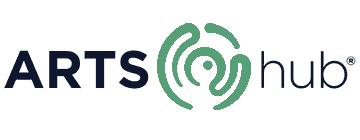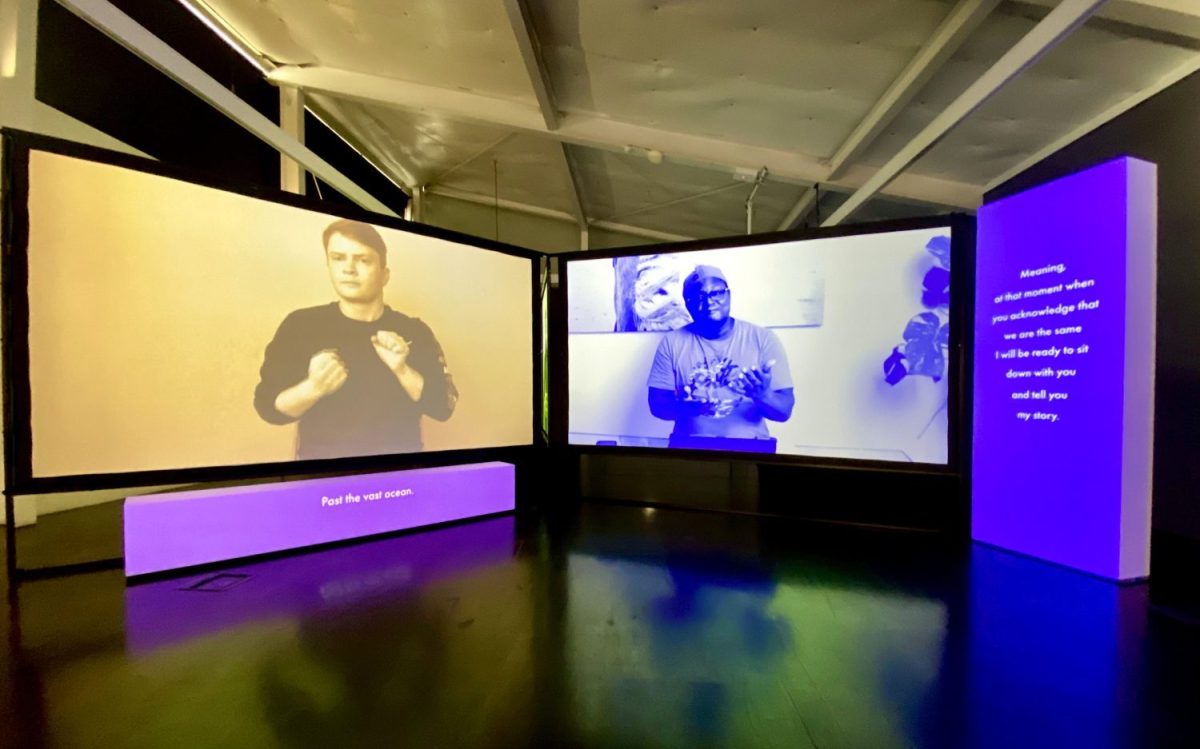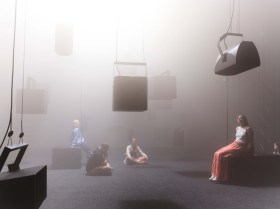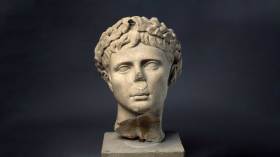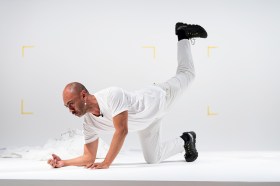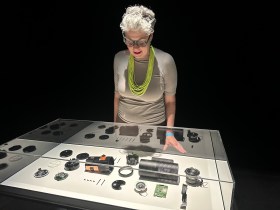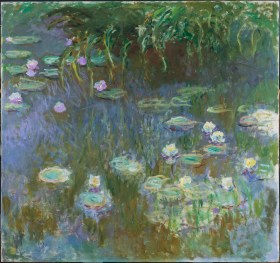What I Wish I’d Told You is an exhibition that has recently opened at Footscray Community Arts in Melbourne’s diverse west side. But more than that, it’s a national project using decolonising strategies and truth-telling to empower and affirm experiences of Deafhood.
Led by Deaf artist Chelle Destefano and Deaf advocate and artist Claire Bridge, the project engaged more than 70 Deaf storytellers and hearing allies to pave a new path of accessibility which centres autonomous storytelling over interpreting.
Destefano and Bridge shared with ArtsHub the foundations of this project and the advocacy they share.
What is ’audist colonisation’?
An important context to the exhibition examines audism, a form of discrimination which prioritises hearing people and oppresses those who are d/Deaf.
Bridge explained: ’Audism is the notion that hearing and spoken languages are superior, and that being able to behave as if you can hear and speak is superior and preferred.
‘Audist colonisation is the domination of Deaf people and the control over and erasure of d/Deaf bodies, minds, language, culture, spaces and knowledges.’
This can be seen through the closing of several Deaf schools In Australia, where now only one remains, and many Deaf clubs where community gather were also sold off.
Even in the everyday, audism can take the form of denying Deaf people the right to use sign language or interpreters and excluding Deaf people in conversations and as contributors.
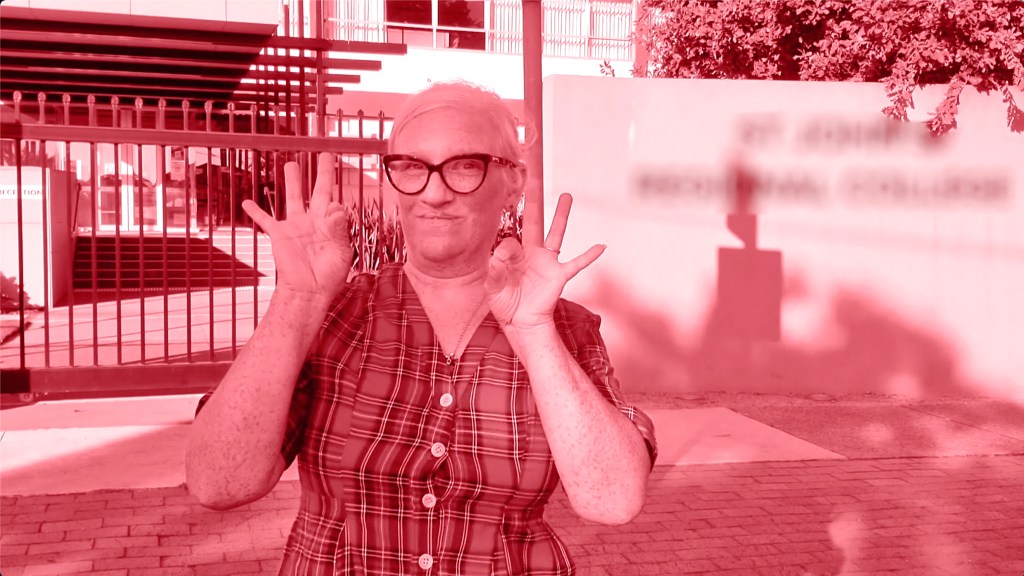
Destefano added: ’The Deaf storytellers in the exhibition celebrate Deaf pride, Deaf language, Deaf culture and maintaining our identity as Deaf people. The show also gives Deaf people the opportunity to see how much power we do have to stand up and ask for our rights for access and equity.
‘Deaf culture goes hand in hand with Auslan. Our stories are empowered voices, with our own agency, being heard and having our Deaf experiences known,’ Destefano wrote.
In Auslan, we pass stories from hand to hand. Our stories cannot be put on a page, detached from us. When we tell stories through sign language, our whole body, mind, emotion, and inner self is also expressed. Our signed stories carry culture.
Chelle Destefano, artist
Through decolonising practices, What I Wish I’d Told You creates a safe space, similar to a Deaf club, for both the Deaf and hearing communities.
Bridge continued: ’Auslan storytelling is not simply storytelling in another language. Auslan storytelling uses sign language, yes, but it also does this in ways that reflect and celebrate Deafhood and Deaf culture. Auslan storytelling is a site of cultural resistance and pride.’
In addition, the project engages a breadth of First Nations and CaLD (culturally and linguistically diverse) practitioners.
This takes into consideration Deaf mob signs that might be used by First Nations people as well as inviting Deaf Aboriginal Services (DAS) advisor Joanna Agius OAM to create an Acknowledgement of Country video in Auslan, displayed at the entrance of the exhibition.
Bridge added: ’Auslan storytelling reclaims language and decolonises the museum by Deaf presences practicing culture in museum and galleries; spaces and institutions which have historically excluded and marginalised Deaf people.’
Accessibility goes both ways
So how does the exhibition strike a balance between carving out a space for Deaf communities while simultaneously creating a welcoming space for hearing communities? And, is it possible to achieve an all-inclusive exhibition and if so, how?
In What I Wish I’d Told You, the contributors start with presenting their stories in Auslan which are then interpreted into English – a case where accessibility goes both ways.
Bridge shared: ’I worked closely with each of the voice-over artists, matching hearing allies who are of similar cultural background or share aspects of identity with the Deaf storyteller, creating transcriptions for them and guiding them on how to match and emote the storytellers in order to empower and support the Deaf storyteller’s own agency. This was necessary to create accessibility.’
As a former Auslan interpreter, Bridge is able to work directly with the Auslan videos to create English captions and voice-overs but the project also invited other allies to participate.
Read: Accessibility toolkit and being an ally
It was also a significant exercise of trust, Bridge shared, as the action of interpreting, by default, signals a transfer of agency between the speaker and signer, and vice versa.
Bridge continued: ‘Without having this specific skill set, and working with our team of professional interpreters, including First Nations interpreter Lucian Remedio, we would not have an accessible exhibition.
‘The cost of Auslan to English translation, from video to transcript is so high it is utterly prohibitive to do this on this scale [without the skills and help of contributors]. We have included 47 Auslan stories, all translated, all captioned and all voiced. An epic undertaking,’ she added.
For organisations, it is important to not only have equity and access as written policies, but to have a plan of actions and strategies to implement access.
Claire Bridge, artist and advocate
Essentially, accessibility is about integration, rather than treating things like Auslan, captions, voice-over and other access offerings as a bonus.
A model for integrated accessibility: points to consider
An access budget
Actually setting money aside to implement accessibility is vital, but might be new territory for a lot of organisations. People with access needs should be involved in a consultation process for the organisation to understand what is actually required.
Having a budget also means that accessibility is among an organisation’s list of priorities. Bridge added: ’Without an access budget, organisations will by default, exclude Deaf people.’
Training and workshops
Accessibility training is necessary for all staff members regardless of whether they work front of house or not. This means ’educating gallery teams on booking access services, and the importance of booking in advance, of asking the [person with disabilities] what they require rather than making assumptions or setting limits on access,’ advised Bridge.
For example, Footscray Community Arts implemented a Deaf Awareness workshop for their staff ahead of What I Wish I’d Told You. It encourages staff to actively create a safe Deaf environment, learn sign language or even just try to use fingerspelling.
Changes to physical environments
Sometimes physical modifications are necessary. Consider whether the space can be easily navigated in a wheelchair or with walking aids, is there furniture blocking the path or a clear line of sight, or harsh light hindering on vision?
Bridge shared: ‘We have presented this in such a way that the exhibition design and aesthetics give primacy to Auslan and critically address the constancy of transferred agency and the imperialism and omnipresence of English.
‘We have also flipped the access script. Our exhibition design allows for Auslan to be viewed from any direction, from the front or rear of the screens, in three-dimensional space in-the-round that is wheelchair accessible.
‘Whereas the English captions are only legible or accessible from specific vantage points. This elucidates some aspects about how “access” is provided and experienced by Deaf people. We have also provided audio, as English language voice-overs for people who are blind,’ Bridge explained.
Access to information
Many might not realise that written information also pose accessibility or inclusivity barriers. Bridge shared that it’s uncommon for written information to be translated into Auslan, but it’s important to acknowledge that ’Auslan is the language of preference of many Deaf people’.
Visitors can access Auslan videos by scanning a QR code of the catalogue essays for the exhibition. She added: ’We hope that these things we have integrated into this exhibition can be models for others to implement to be more inclusive and provide greater access for their organisations and events.’
Mode of collaboration
Destefano reflected: ’As the Deaf person working on this project, I have been unpacking my Deaf identity myself and things I had not known about my Deafness, such as audism, the effect of oppression and my rights to ask for access and not to apologise for being Deaf.
‘It has been a great experience working with Claire, a strong Deaf ally who understands the Deaf community, language, and culture, having grown up around the Deaf community, having Deaf grandparents and herself working as an Auslan interpreter for many years.’
Destefano continued: ‘Claire always made sure my voice was included in everything, where I would write my perspectives as a Deaf person, which is very important as the Deaf collaborator. Claire and I have been equal with our voices and perspectives.’
Bridge added: ’A great collaboration is one where various skills are recognised, and contributions can be made from places of strength for each collaborator. It doesn’t mean the same or equal contribution necessarily, but rather a focus on the contributions that are of benefit for the project.
‘Respect and clear, open and inclusive communication are key. Trust is essential,’ she concluded.
What I Wish I’d Told You runs until 28 August at Footscray Community Arts; the exhibition launches with an opening event on 23 July 3 – 5 pm.
The exhibition will tour VIC and NSW in 2023.
